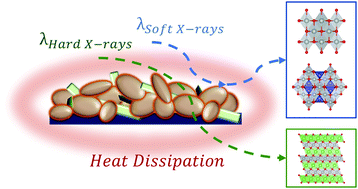Multimodal electrochemistry coupled microcalorimetric and X-ray probing of the capacity fade mechanisms of Nickel rich NMC – progress and outlook†
Abstract
Lithium nickel manganese cobalt oxide (NMC) is a commercially successful Li-ion battery cathode due to its high energy density; however, its delivered capacity must be intentionally limited to achieve capacity retention over extended cycling. To design next-generation NMC batteries with longer life and higher capacity the origins of high potential capacity fade must be understood. Operando hard X-ray characterization techniques are critical for this endeavor as they allow the acquisition of information about the evolution of structure, oxidation state, and coordination environment of NMC as the material (de)lithiates in a functional battery. This perspective outlines recent developments in the elucidation of capacity fade mechanisms in NMC through hard X-ray probes, surface sensitive soft X-ray characterization, and isothermal microcalorimetry. A case study on the effect of charging potential on NMC811 over extended cycling is presented to illustrate the benefits of these approaches. The results showed that charging to 4.7 V leads to higher delivered capacity, but much greater fade as compared to charging to 4.3 V. Operando XRD and SEM results indicated that particle fracture from increased structural distortions at >4.3 V was a contributor to capacity fade. Operando hard XAS revealed significant Ni and Co redox during cycling as well as a Jahn–Teller distortion at the discharged state (Ni3+); however, minimal differences were observed between the cells charged to 4.3 and 4.7 V. Additional XAS analyses using soft X-rays revealed significant surface reconstruction after cycling to 4.7 V, revealing another contribution to fade. Operando isothermal microcalorimetry (IMC) indicated that the high voltage charge to 4.7 V resulted in a doubling of the heat dissipation when compared to charging to 4.3 V. A lowered chemical-to-electrical energy conversion efficiency due to thermal energy waste was observed, providing a complementary characterization of electrochemical degradation. The work demonstrates the utility of multi-modal X-ray and microcalorimetric approaches to understand the causes of capacity fade in lithium-ion batteries with Ni-rich NMC.

- This article is part of the themed collection: PCCP Perspectives


 Please wait while we load your content...
Please wait while we load your content...